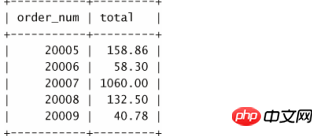使用游標數據
在一個游標被打開后,可以使用 FETCH 語句分別訪問它的每一行。FETCH 指定檢索什么數據(所需的列),檢索出來的數據存儲在什么地方。它還向前移動游標中的內部行指針,使下一條 FETCH 語句檢索下一行(不重復讀取同一行)。
第一個例子從游標中檢索單個行(第一行):
輸入:
create?procedure?processorders() BEGIN --?declare?local?variables declare?o?int; --?declare?the?cursor declare?ordernumbers?cursor for select?order_num?from?orders: --?open?the?cursor open?ordernumbers; --?get?order?number fetch?ordernumbers?into?o; --?close?the?cursor close?ordernumbers; end;
分析:其中 FETCH 用來檢索當前行的 order_num 列(將自動從第一行開始)到一個名為 o 的局部聲明的變量中。對檢索出的數據不做任何處理。
在下一個例子中,循環檢索數據,從第一行到最后一行:
輸入:
create?procedure?processorders() BEGIN --?declare?local?variables declare?done?boolean?default?0; declare?o?int; --?declare?the?cursor declare?ordernumbers?cursor for select?order_num?from?orders: --declare?continue?handler declare?continue?handler?for?sqlstate?'02000'?set?done?=?1; --?open?the?cursor open?ordernumbers; --loop?through?all?rows repeat --?get?order?number fetch?ordernumbers?into?o; --?end?of?loop until?done?end?repeat; --?close?the?cursor close?ordernumbers; end;
分析:與前一個例子一樣,這個例子使用 FETCH 檢索當前 order_num到聲明的名為 o 的變量中。但與前一個例子不一樣的是,這個例子中的 FETCH 是在 REPEAT 內,因此它反復執行直到 done 為真(由 UNTILdone END REPEAT; 規定)。為使它起作用,用一個 DEFAULT 0 (假,不結束)定義變量 done 。那么, done 怎樣才能在結束時被設置為真呢?答案是用以下語句:
declare?continue?handler?for?sqlstate?'02000'?set?done?=?1;
這條語句定義了一個 CONTINUE HANDLER ,它是在條件出現時被執行的代碼。這里,它指出當 SQLSTATE ‘02000’ 出現時, SET done=1。SQLSTATE ‘02000’ 是一個未找到條件,當 REPEAT 由于沒有更多的行供循環而不能繼續時,出現這個條件。
MySQL的錯誤代碼 關于MySQL 5使用的MySQL錯誤代碼列表,請參閱http://dev.mysql.com/doc/mysql/en/error-handling.html。
DECLARE 語句的次序 DECLARE 語句的發布存在特定的次序。用 DECLARE 語句定義的局部變量必須在定義任意游標或句柄之前定義,而句柄必須在游標之后定義。不遵守此順序將產生錯誤消息。
如果調用這個存儲過程,它將定義幾個變量和一個 CONTINUE HANDLER ,定義并打開一個游標,重復讀取所有行,然后關閉游標。如果一切正常,你可以在循環內放入任意需要的處理(在 FETCH 語句之后,循環結束之前)。
重復或循環? 除這里使用的 REPEAT 語句外,MySQL還支持循環語句,它可用來重復執行代碼,直到使用 LEAVE 語句手動退出為止。通常 REPEAT 語句的語法使它更適合于對游標進行循環。
為了把這些內容組織起來,下面給出我們的游標存儲過程樣例的更進一步修改的版本,這次對取出的數據進行某種實際的處理:
輸入:
create?procedure?processorders() BEGIN --?declare?local?variables declare?done?boolean?default?0; declare?o?int; declare?t?decimal(8,2); --?declare?the?cursor declare?ordernumbers?cursor for select?order_num?from?orders; --?declare?continue?handler declare?continue?handler?for?sqlstate?'02000'?set?done?=?1; --?create?a?table?to?store?the?results create?table?if?not?exists?ordertotals (order_num?int,?total?decimal(8,2)); --?open?the?cursor open?ordernumbers; --?loop?through?all?rows repeat --?get?order?number fetch?ordernumbers?into?o; --?get?the?total?for?this?order call?ordertotal(o,1,t); --?insert?order?and?total?into?ordertotals insert?into?ordertotals(order_num,total) values(o,t); --?end?of?loop until?done?end?repeat; --?close?the?cursor close?ordernumbers; END;
分析:在這個例子中,我們增加了另一個名為 t 的變量(存儲每個訂單的合計)。此存儲過程還在運行中創建了一個新表(如果它不存在的話),名為 ordertotals 。這個表將保存存儲過程生成的結果。 FETCH像以前一樣取每個 order_num ,然后用 CALL 執行另一個存儲過程(我們在前一章中創建)來計算每個訂單的帶稅的合計(結果存儲到 t )。最后,用 INSERT 保存每個訂單的訂單號和合計。
此存儲過程不返回數據,但它能夠創建和填充另一個表,可以用一條簡單的 SELECT 語句查看該表:
輸入:
select?*?from?ordertotals;
輸出:

這樣,我們就得到了存儲過程、游標、逐行處理以及存儲過程調用其他存儲過程的一個完整的工作樣例。


















